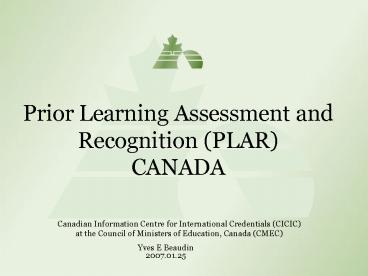Prior Learning Assessment and Recognition (PLAR) CANADA - PowerPoint PPT Presentation
1 / 20
Title:
Prior Learning Assessment and Recognition (PLAR) CANADA
Description:
... and promote opportunities for interaction with and among PLAR practitioners. ... Industry. Canadian Association of Prior Learning Assessment (CAPLA) ... – PowerPoint PPT presentation
Number of Views:79
Avg rating:3.0/5.0
Title: Prior Learning Assessment and Recognition (PLAR) CANADA
1
Prior Learning Assessment and Recognition
(PLAR)CANADA
Canadian Information Centre for International
Credentials (CICIC) at the Council of Ministers
of Education, Canada (CMEC)
- Yves E Beaudin2007.01.25
2
INTRODUCTION- Education in Canada falls
under provincial and territorial jurisdiction
(10 provinces 3 territories)- PLAR policies
will vary in the provinces and territories-
Widely accepted in universities, colleges,
professional regulatory bodies, certification
boards, industry, etc.
3
Role of Governments
- Research
- Policy / Frameworks
- Financial support
- Guidelines
4
Universities
- autonomous organizations with individual
governance and discretion in terms of policies - responsible for their quality assurance
processes - set academic standards and develop assessment
methods and procedures for accessing formal,
non-formal and informal prior learning for
admissions or credit purposes.
5
Policies and Procedures
- 50 universities with policies and procedures
- Institutional policies
- Departmental policies
6
PersonnelMost universities have personnel
dedicated to PLAR activities at the institutional
or the departmental (faculty) level
7
Credit transfer and PLAR
- Credit transfer system used towards a university
degree - Challenge for Credit towards a specific course
- Some universities use portfolio assessments and
credit challenge to award credit for non-formal
and informal learning towards a degree program
8
Best Practices in Prior Learning Assessment and
Recognition (PLAR)
- PLAR implementation is not standardized. The
development of a coordinated prior learning
assessment strategy based on current best
practices is something that needs further
exploration.
9
Some institutions would like to
- Collaborate with other post-secondary
institutions to develop clear definitions,
standards and assessment practices for PLAR - Initiate and support PLAR networks or working
groups to create a forum for sharing ideas and
conducting research
10
- Increase professional development opportunities
by providing access to courses and conferences
and promote opportunities for interaction with
and among PLAR practitioners. There is an
abundance of knowledge and experience in this
field. - Provide clear reasons for unsuccessful
assessments of prior learning and include a clear
explanation as to how the individuals
qualifications were assessed. - Provide unsuccessful applicants the right to
appeal. Appeals should not be heard by persons
involved in the original decision.
11
Fees
- Most have fees associated to PLAR except where
base funding is provided - Students address the financial strain of the fees
required
12
Other
- In most cases no distinctive codes are accorded
to credits obtained through alternate assessment
methods. - PLAR participants report having received better
pay, benefits, improved career prospects, and as
an accompaniment to academic accomplishment, have
a better quality of life - Women, in particular, have benefited from PLAR
13
- PLAR students have been shown to engage in more
continued lifelong learning. They take more
courses and are more likely to engage in post
diploma studies - Recognition is applied to various certificate,
diploma, and degree programs
14
- Most PLAR participants indicate that PLAR was
valuable, some believe that too much work was
involved for the maximum amount of credit that
could be received.
15
Resistance
- Higher education institutions have been slow to
change - Institutions cite inadequate funding to train and
compensate advisors and assessors and to create
tools and resources, administrative procedures,
and gap training. For faculty, who already
report being overloaded, the additional tasks
come with no recognition to them or increase in
pay.
16
- The formal education sector is concerned with
standards, quality assurance and dealing with the
demands placed on the institution
17
- Acceptance of non-formal and informal learning
may lead to quality assurance issues - Academically, institutions may refuse to
recognize transfer credit transcripted as having
been obtained through PLAR
18
- Colleges
- Professional Regulatory Bodies
- Certification Boards
- Industry
19
- Canadian Association of Prior Learning Assessment
(CAPLA) - Canadian Institute for Recognizing Learning
(CIRL) - Canadian Information Centre for International
Credentials
20
Questions - Discussion































